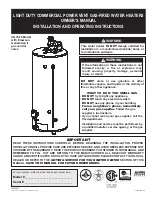
4
This panel must extend at least three (3) inches
(7.6 cm) beyond the width and depth of the water
heater. Should the water heater be installed in an
alcove or closet, the entire floor area must be covered
by the panel.
2''
min.
2''
min.
4''
min.
18''
min.
2''
min.
Figure 1
Minimum Clearances
The minimum clearances from combustible material
for this water heater are: Two (2) inches (5.1 cm)
from the sides and rear, four (4) inches (10.2 cm)
from the front, and eighteen (18) inches (45.7 cm)
from the top (
see Figure 1
).
1,000 BTU/hr
1,000 BTU/hr
4,000 BTU/hr
4,000 BTU/hr
4,000 BTU/hr
2,000 BTU/hr
2,000 BTU/hr
Espace confiné
Espace confiné
Espace
confiné
Espace
confiné
Espace
confiné
Espace
confiné
(min.: 100 po
2
)
1 po
2
1 po
2
Entrée d’air
Alternative
Entrée d’air du
sous-sol
1 po
2
1 po
2
d’entrée d’air
Entrée
1 po
2
1 po
2
Figure 2
Combustion and Ventilation Air Supply
In order for the water heater to operate properly, it must
be supplied with an uninterrupted flow of clean com-
bustion and ventilation air. The area around the water
heater must always be kept clear and the combustion
air intake holes at the bottom of the water heater must
never be blocked. An inadequate supply of air to the
water heater will produce a bright yellow burner flame
causing sooting in the combustion chamber, on the
burner and in the flue tube. This can result in damage
to the water heater and serious bodily injury, if not cor-
rected.
Combustion and ventilation air requirements are deter-
mined by where the water heater is to be located.
Water heaters are installed in either open (unconfined)
spaces or smaller (confined) spaces, such as closets
or small rooms.
Requirements for Unconfined Spaces
An unconfined space is an area with at least
fifty (50)
ft
3
/1,000 BTU (4.8 m
3
/kW)
of the total input rating for all
gas appliances installed in that space. Water heaters
installed in unconfined spaces do not usually require
outdoor air to function properly. However, in buildings
with tight construction (heavy insulation, vapour barri-
ers, weather stripping, etc.) and particularly in mod-
ern buildings, additional fresh air may need to be
provided. For instructions on obtaining additional air
supply, see the requirements below for confined
spaces.
Requirements for Confined Spaces
A confined space is an area where the volume is less
than
fifty (50) ft
3
/1,000 BTU (4.8 m
3
/kW)
of the total
input rating for all gas appliances installed in that space.
Water heaters installed in confined spaces require addi-
tional air. This can be provided in two ways:
In Canada (refer to CAN/CSA B149.1)
1)
All Air From Inside the Building (see Figure 2):
The confined space shall be provided with
one opening of
one (1) in
2
/1,000 BTU (22.0 cm
2
/kW)
communicating directly with one or more rooms
of sufficient volume, so that the combined volume
of all spaces meets the criteria for an unconfined
space for all the appliances installed in that
confined space.
1,000 BTU/hr
1,000 BTU/hr
4,000 BTU/hr
4,000 BTU/hr
4,000 BTU/hr
2,000 BTU/hr
2,000 BTU/hr
Espace confiné
Espace confiné
Espace
confiné
Espace
confiné
Espace
confiné
Espace
confiné
(min.: 100 po
2
)
1 po
2
1 po
2
Entrée d’air
Alternative
Entrée d’air du
sous-sol
1 po
2
1 po
2
d’entrée d’air
Entrée
1 po
2
1 po
2
Figure 3
2)
All Air From Outdoors: (see Figure 3):
An air supply shall be provided with one opening that
communicates directly with the outdoors by means of
a duct. This duct shall be sized according to CAN/
CSA B149.1 and terminate within one (1) foot
(30.5 cm) above and within two (2) feet (61 cm) hori-
zontally from the burner level of the appliance having
the largest input.
INSTALLATION INSTRUCTIONS





































